关于房地产金融的论文
我国房地产金融风险论文

浅析我国房地产金融风险【摘要】房地产业是国民经济最的支柱性产业,是一个投资巨大、回收缓慢、回报丰厚、具有风险的极其复杂的系统工程,对整个金融业和国民经济的稳定与发展也至关重要。
文章分析了我国房地产业的现状,描述了当前我国房地产金融风险的集中表现,并在此基础上提出了必要的风险防范措施。
【关键词】房地产;金融风险;风险防范1 我国房地产风险现状房地产开发资金过多依赖于银行贷款,使得房地产投资的市场风险和融资信用风险集中于商业银行。
另一方面,我国目前的房地产资金链中,商业银行基本参与了房地产开发的全过程。
通过信房消费贷款、房地产开发贷款、建筑企业流动性贷款和土地储备贷款等各种形式的信贷资金集中,商业银行实际上直接间接承受了房地产市场运行中各个环节的市场风险和信用风险。
土地储备制度不完善,土地储备贷款存在隐必风险。
在目前我国土地储备制度下,土地被政府部门高度垄断。
在土地出让过程中,地方政府出于土地收益的考虑,往往希望获得较高的土地溢价。
由于各地城市开发和改造的盘子都非常大,而且土地资产价值往往很高,因此,土地购置的融资要求十分巨大,而土地收购和开发的主要资金来源于银行贷款,还款则主要依靠土地出让金。
这就增加了土地购置与开发贷款的隐含风险。
事实上,从目前情况看,在很多地方,巨额的银行信贷资金使土地储备动作机构的贷款利息负担十分沉重,地方政府为此承担了巨大的包袱。
个人住房消费信贷的发展可能存在违约风险。
商业银行普遍把个人购房贷款看成优良资产而不遗余力地大力发燕尾服。
依照国际惯例,个人房贷的风险显露期通常为3--8年。
我国个人征信系统尚未建立,商业银行也难以对贷款人的贷款行为和资信善进行充分严格的调查监控。
商业银行也难以对贷款人的贷款行为和资信善进行充分严格的调查监控。
而且,未来房价的波动和利率的变化也在一定程度上加大了拖欠还款的信用风险。
商业银行和其他金融机构存在经营行为本身不理性、不规范等问题。
由于商业银行普遍把房地产信贷作为一种“优良资金”大力发展”,在经营业务上容易产生急功近利的倾向。
房地产金融论文
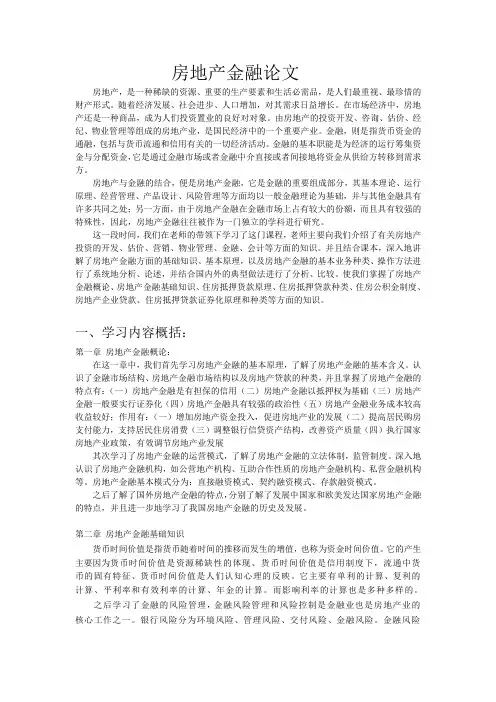
房地产金融论文房地产,是一种稀缺的资源、重要的生产要素和生活必需品,是人们最重视、最珍惜的财产形式。
随着经济发展、社会进步、人口增加,对其需求日益增长。
在市场经济中,房地产还是一种商品,成为人们投资置业的良好对对象。
由房地产的投资开发、咨询、估价、经纪、物业管理等组成的房地产业,是国民经济中的一个重要产业。
金融,则是指货币资金的通融,包括与货币流通和信用有关的一切经济活动。
金融的基本职能是为经济的运行筹集资金与分配资金,它是通过金融市场或者金融中介直接或者间接地将资金从供给方转移到需求方。
房地产与金融的结合,便是房地产金融,它是金融的重要组成部分,其基本理论、运行原理、经营管理、产品设计、风险管理等方面均以一般金融理论为基础,并与其他金融具有许多共同之处;另一方面,由于房地产金融在金融市场上占有较大的份额,而且具有较强的特殊性,因此,房地产金融往往被作为一门独立的学科进行研究。
这一段时间,我们在老师的带领下学习了这门课程,老师主要向我们介绍了有关房地产投资的开发、估价、营销、物业管理、金融、会计等方面的知识。
并且结合课本,深入地讲解了房地产金融方面的基础知识、基本原理,以及房地产金融的基本业务种类、操作方法进行了系统地分析、论述,并结合国内外的典型做法进行了分析、比较。
使我们掌握了房地产金融概论、房地产金融基础知识、住房抵押货款原理、住房抵押贷款种类、住房公积金制度、房地产企业贷款、住房抵押贷款证券化原理和种类等方面的知识。
一、学习内容概括:第一章房地产金融概论:在这一章中,我们首先学习房地产金融的基本原理,了解了房地产金融的基本含义。
认识了金融市场结构、房地产金融市场结构以及房地产贷款的种类,并且掌握了房地产金融的特点有:(一)房地产金融是有担保的信用(二)房地产金融以抵押权为基础(三)房地产金融一般要实行证券化(四)房地产金融具有较强的政治性(五)房地产金融业务成本较高收益较好;作用有:(一)增加房地产资金投入,促进房地产业的发展(二)提高居民购房支付能力,支持居民住房消费(三)调整银行信贷资产结构,改善资产质量(四)执行国家房地产业政策,有效调节房地产业发展其次学习了房地产金融的运营模式,了解了房地产金融的立法体制,监管制度。
房地产经济学论文范文精选3篇(全文)
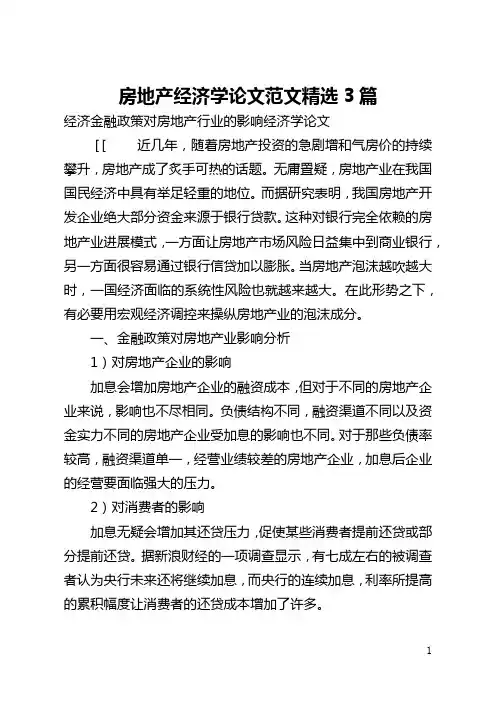
房地产经济学论文范文精选3篇经济金融政策对房地产行业的影响经济学论文[[近几年,随着房地产投资的急剧增和气房价的持续攀升,房地产成了炙手可热的话题。
无庸置疑,房地产业在我国国民经济中具有举足轻重的地位。
而据研究表明,我国房地产开发企业绝大部分资金来源于银行贷款。
这种对银行完全依赖的房地产业进展模式,一方面让房地产市场风险日益集中到商业银行,另一方面很容易通过银行信贷加以膨胀。
当房地产泡沫越吹越大时,一国经济面临的系统性风险也就越来越大。
在此形势之下,有必要用宏观经济调控来操纵房地产业的泡沫成分。
一、金融政策对房地产业影响分析1)对房地产企业的影响加息会增加房地产企业的融资成本,但对于不同的房地产企业来说,影响也不尽相同。
负债结构不同,融资渠道不同以及资金实力不同的房地产企业受加息的影响也不同。
对于那些负债率较高,融资渠道单一,经营业绩较差的房地产企业,加息后企业的经营要面临强大的压力。
2)对消费者的影响加息无疑会增加其还贷压力,促使某些消费者提前还贷或部分提前还贷。
据新浪财经的一项调查显示,有七成左右的被调查者认为央行未来还将继续加息,而央行的连续加息,利率所提高的累积幅度让消费者的还贷成本增加了许多。
3)对房价的影响房价在短期内受加息影响较小,但未来房价增长将趋于:XX://平缓。
宏观金融政策本身的性质决定了其真正凸现于经济进展的成效上需要相当长的一段时间。
加息对于购房者来说意味着购房支出的增加,这实际上是央行在削减对贷款购房者的支持力度,降低其购买力。
而购买力的降低必定会减少对房地产需求,这种对需求的抑制作用将最终决定供给,从而操纵过高的房价,产生积极的降温作用,使房价回归理性。
1、存款准备金率政策根据经济学原理,上调法定存款准备金率会对货币供应总量产生乘数效应:当提高存款准备金率时,货币乘数减小,商业银行可运用的资金减少,贷款能力下降,货币流通量相应以一定比率减少。
但是据商业银行的数据显示,个人住房贷款并未因房价上涨、加息等因素影响而大幅减少。
房地产金融论文--浅析抵押贷款证券化的优劣势
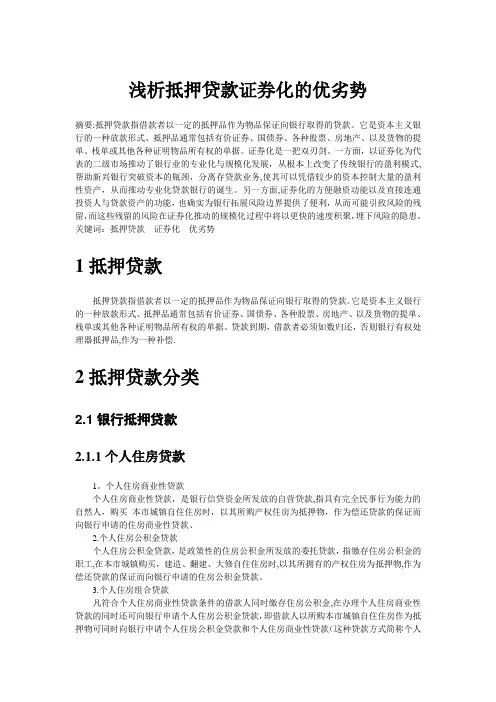
浅析抵押贷款证券化的优劣势摘要:抵押贷款指借款者以一定的抵押品作为物品保证向银行取得的贷款。
它是资本主义银行的一种放款形式、抵押品通常包括有价证券、国债券、各种股票、房地产、以及货物的提单、栈单或其他各种证明物品所有权的单据。
证券化是一把双刃剑。
一方面,以证券化为代表的二级市场推动了银行业的专业化与规模化发展,从根本上改变了传统银行的盈利模式,帮助新兴银行突破资本的瓶颈,分离存贷款业务,使其可以凭借较少的资本控制大量的盈利性资产,从而推动专业化贷款银行的诞生。
另一方面,证券化的方便融资功能以及直接连通投资人与贷款资产的功能,也确实为银行拓展风险边界提供了便利,从而可能引致风险的残留,而这些残留的风险在证券化推动的规模化过程中将以更快的速度积聚,埋下风险的隐患。
关键词:抵押贷款证券化优劣势1抵押贷款抵押贷款指借款者以一定的抵押品作为物品保证向银行取得的贷款。
它是资本主义银行的一种放款形式、抵押品通常包括有价证券、国债券、各种股票、房地产、以及货物的提单、栈单或其他各种证明物品所有权的单据。
贷款到期,借款者必须如数归还,否则银行有权处理器抵押品,作为一种补偿.2抵押贷款分类2.1银行抵押贷款2.1.1个人住房贷款1。
个人住房商业性贷款个人住房商业性贷款,是银行信贷资金所发放的自营贷款,指具有完全民事行为能力的自然人,购买本市城镇自住住房时,以其所购产权住房为抵押物,作为偿还贷款的保证而向银行申请的住房商业性贷款、2.个人住房公积金贷款个人住房公积金贷款,是政策性的住房公积金所发放的委托贷款,指缴存住房公积金的职工,在本市城镇购买,建造、翻建、大修自住住房时,以其所拥有的产权住房为抵押物,作为偿还贷款的保证而向银行申请的住房公积金贷款。
3.个人住房组合贷款凡符合个人住房商业性贷款条件的借款人同时缴存住房公积金,在办理个人住房商业性贷款的同时还可向银行申请个人住房公积金贷款,即借款人以所购本市城镇自住住房作为抵押物可同时向银行申请个人住房公积金贷款和个人住房商业性贷款(这种贷款方式简称个人住房组合贷款)。
英文论文关于金融危机对房地产的影响的论文英文版完美版
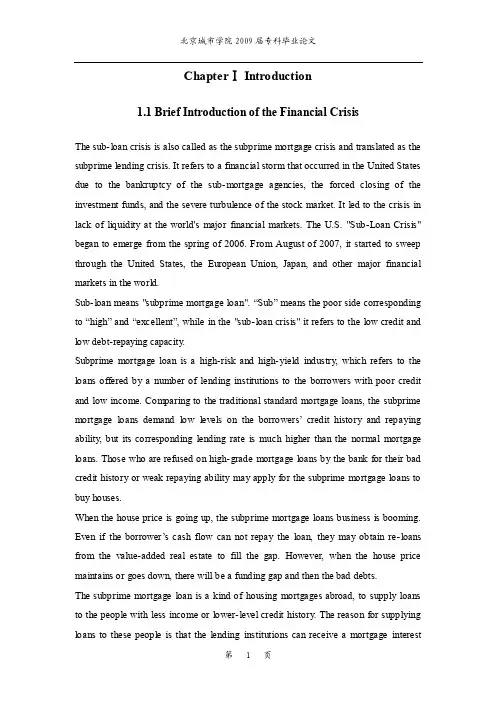
ChapterⅠ Introduction1.1 Brief Introduction of the Financial CrisisThe sub-loan crisis is also called as the subprime mortgage crisis and translated as the subprime lending crisis. It refers to a financial storm that occurred in the United States due to the bankruptcy of the sub-mortgage agencies, the forced closing of the investment funds, and the severe turbulence of the stock market. It led to the crisis in lack of liquidity at the world's major financial markets. The U.S. "Sub-Loan Crisis" began to emerge from the spring of 2006. From August of 2007, it started to sweep through the United States, the European Union, Japan, and other major financial markets in the world.Sub-loan means "subprime mortgage loan". “Sub” means the poor side corresponding to “high” and “excellent”, while in the "sub-loan crisis" it refers to the low credit and low debt-repaying capacity.Subprime mortgage loan is a high-risk and high-yield industry, which refers to the loans offered by a number of lending institutions to the borrowers with poor credit and low income. Comparing to the traditional standard mortgage loans, the subprime mortgage loans demand low levels on the borrowers’ credit history and repaying ability, but its corresponding lending rate is much higher than the normal mortgage loans. Those who are refused on high-grade mortgage loans by the bank for their bad credit history or weak repaying ability may apply for the subprime mortgage loans to buy houses.When the house price is going up, the subprime mortgage loans business is booming. Even if the borrower’s cash flow can not repay the loan, they may obtain re-loans from the value-added real estate to fill the gap. However, when the house price maintains or goes down, there will be a funding gap and then the bad debts.The subprime mortgage loan is a kind of housing mortgages abroad, to supply loans to the people with less income or lower-level credit history. The reason for supplying loans to these people is that the lending institutions can receive a mortgage interesthigher than the good credit mortgage. When the house prices rise, the loans will have no problems as a result of adequate value in pledge; but when the house prices fall, value in pledge is no longer sufficient, while the mortgager has less income, thus the loan contract may be breached and the house may be returned to the bank. It will cause the increase in the bad debts of the mortgager, the collapsed cases of the mortgage providers and the risks in the financial markets.1.2 Importance of Real Estate Industry on Beijing's GDP(Proportion)The added value of real estate industry accounts for more than 5% of the gross domestic product (GDP) in our country. As a pillar industry, it has played an important role in the national economy.Yu Xiuqin, the spokeswoman of Beijing Municipal Bureau of Statistics said on October 14, 2004, that Beijing’s GDP in the first quarter increased 13% over the same period of the previous year. The released Real Estate Investment Report by the Fixed Assets Investment Division of Beijing Municipal Development and Reform Commission on October 15 indicated that the investment growth rate in the first three quarters reduced to 20.3% from 40.6% in the first quarter, "ranking in a more reasonable range." But the Report also pointed out that the great dropping in the real estate investment "leading indicators (land development, etc.)” undoubtedly affected the potential growth of investment in real estate. The delayed impact from macro-control measures shall be paid attentions to." This Report obviously reminded that the development and investment in real estate may maintain the downward trend due to the impact of macro-control, and it may further have a certain impact on Beijing’s economic growth.What impact can macro-control br ing on Beijing’s GDP? Ding Xiangyang, Director of Beijing Municipal Development and Reform Commission, said when he reported to Beijing People's Congress Standing Committee on the implementation of nationaleconomic and social development plan during the first half year, that a series of land policies in Beijing such as the moratorium on agricultural land requisition, the ceasing of agreed land transfer, and the clean-up of investment projects in development zones, as well as the macro-control, had probably effected an investment of about RMB 120 billion yuan, with about 2-3 percentage points on affecting the annual economic growth in the next few years. The Report of the Fixed Assets Investment Division finally showed that from the investment in recent years, the proportion of real estate investment had always been maintained at above 55%, which did not match the direction of industrial restructuring on developing high-tech industries and modern manufacturing sectors. In order to maintain the consecutive and stable economic growth of the city and optimize the industrial structure, it is necessary to intensify the investment structure adjustment and increase the proportion of industrial investment, especially under the circumstances that the potentials in the real estate industry are affected."We can see such a logic relationship: the real estate investment maintains a high proportion in recent years, while the macro-control reduces the real estate investment growth rate, which will annually decrease several p ercentage points of Beijing’s GDP in the next few years. Real estate has an extraordinary impact on Beijing's economy. The proportion of real estate investment is too large? According to the planning of National Development and Reform Commission, Beijing City has cleaned up the fixed assets projects in the city. From the information of Beijing Municipal Development and Reform Commission, there are more than 6000 projects being cleaned up, in which more than 600 projects involved in violations. Among them, there are 53 projects being stopped the construction or cancelled and 554 projects being suspended the construction for rectification, with a total investment amount of RMB 164 billion yuan, accounting for 1/5 of the total number in our country. From the project clean-up situation, there is still more than 50% of investment concentrated in the real estate field among all the city's investment projects being constructed or planned for construction. Figures show that the real estate investment in Beijingaccounts for 56.5% of the total investment in the entire society, far exceeding the national average level of 18%. The Report of the Fixed Assets Investment Division of Beijing Municipal Development and Reform Commission suggests that the proportion of real estate investment is too large, "and this does not match the direction of industrial restructuring on developing high-tech industries and modern manufacturing sectors."However, Ren Zhiqiang, President of Huayuan Group who researches much on the economic indexes said, "Beijing originally has a lot of lands for use, but the Capital has not implemented constructions for a long time, and now the construction develops after conquering great difficulties, a higher proportion of real estate investment is normal." Professor Y e Jianping, Head of the Land Management Division of Renmin University of China, considered that demands for housing and the supply in Beijing in recent years had promoted the proportion growth of investment, although this proportion of 56.5% was much higher than the international average level. However, it is very difficult to evaluate whether it is right or not at special stages in a specific period." Nevertheless, there must be problems if such proportion maintains in a long period." Someone in the Fixed Assets Investment Division of Beijing Municipal Development and Reform Commission said that a higher proportion in real estate investment has certain rationality at the present stage on accelerating urban transformation, urbanization and economic growth. And now all aspects of the real estate industry are still within the safety line in general. A large number of bubble phenomenon such as housing vacancy or price skyrocketing have not occurred. But he also pointed out at the same time that it was very easy to emerge bubbles as the real estate industry was greatly affected by the policy. Therefore Beijing, as a large-sized city, if the proportion of real estate investment is too large, the city’s whole economy will accordingly become more vulnerable.Who is the largest contributor to GDP? The official data from Beijing Municipal Development and Reform Commission show that the direct pulling role of real estate on Beijing’s GDP is between 5% and 10%. Experts believe that the direct contributionof the real estate industry to GDP completely results from the demand growth in the real estate market. It is reported that the volume of demolition in Beijing reduces at the annual rate of 20% for 5 consecutive years. There were about 100,000 removing households in Beijing 5 years ago, but in 2004 there were only 20,000. In the past a considerable portion of the demand in Beijing real estate market consists of urban renewal, infrastructure construction as well as a large number of demolitions invested by the government. Now although the government demolitions decline a lot, the consumption amount has not reduced, thus the real estate market remains a strong demand. "With this demand, the relatively high proportion of real estate in GDP is quite normal, because Beijing's real estate is not for Beijing City only, but for the whole country and even the world."In addition to the pulling role of the strong demands in real estate market on Beijing’s GDP, it is well known that the real estate industry drives its upstream and downstream industries. Someone in Beijing Municipal Development and Reform Commission disclosed: "According to the sales estimation, the proportion of real estate and the relevant industries such as its driven raw materials and service industry is about 1:1.2." "Real estate investment can drive a dozen of or a hundred of related industries." Ren Zhiqiang had his personal experience. He considered that from an investment view, the real estate industry could stimulate many affiliated industries, thus it had a great impact on the whole GDP. But he also said that the current method of calculating GDP was on the basis of the net investment amount, excluding the consumption, whereas the related consumption of real estate such as second-hand housing transaction was a very important part of the real estate industry. Therefore he thought that the statistical methods on GDP was not entirely correct, which could not calculate accurately the specific contribution value of the real estate industry. What he implicated was that: the present statistics were incomplete, and the polling function of the real estate industry on GDP had been underestimated.Macro-control on the balance beam: more than one expert warned that the long-term development of a city could not rely on continuous investment though real estateplayed an important role in driving the fixed assets investment and GDP. It should develop more industries. Only the driving industries can bring sustainable development, no matter what it is the first, second or third industry. Someone in the Investment Division of Beijing Municipal Development and Reform Commission introduced that for the adjustment of investment structure, the Municipal Development and Reform Commission at present had established a long-term guideline aiming at reducing the proportion of real estate in the fixed assets investment in Beijing: to change the structure with so large real estate investment at present by increasing the investment on other industries and fields, rather than limiting the current real estate projects, in order to increase the growth points of the city and avoid large effects on the whole economy resulted from the changing real estate industry. At the same time, we shall strengthen market monitoring and analysis, guide the restructuring of real estate products, focus on developing the mid-priced residential houses, and expand the size of second-hand housing market etc. "But the government has the responsibility to control the real estate for avoiding major fluctuations." The staff in the Investment Division of the Development and Reform Commission said that people in the real estate industry were more psychologically vulnerable to the effects of the outside world. Therefore the misconduct may result in insufficient investment in real estate, declining engineering volume, effecting the development of the relevant service and raw material industries, and finally directly or indirectly affecting the entire GDP growth." So the real estate investment, no matter it is up or down, should be a smooth process. It shall follow the principle of ensuring a smooth and stable development in real estate, to prevent the sharp ups and downs." The information on our country’s real estate and construction of 2007 shows that there are 63,000 real estate development enterprises in 2007, with a total employment of 1,720,000 people; the completed investment on real estate development is RMB 2.5289 trillion yuan, with an increase rate of 30. 2%.Statistics show that the asset-liability ratio of China's real estate development enterprise in 2007 was 74.4%; the real estate development enterprises realized a totalprofit of RMB 290 billion yuan, with an increase rate of 48.4%.The released information also shows that China's real estate industry in 2007 still has problems such as irrational housing supply structure, high housing prices and so on. Statistics show that in 2007 the affordable housing investment accounts for 4.6% in the commercial residential investment, reducing 0.5 percentage points; residential housing under 90 square meters only accounts for 23.3% in the commercial residential housing; the real estate sales areas reduced a lot at the end of the year.ChapterⅡ Financial CrisisThe real estate industry is the leading industry of China's national economy, which ranks a decisive position in the modern social and economic life. After more than ten years of development, China's real estate industry is in the transition period towards to a large-scaled, branding and standardized operation. The growth means of the real estate industry is changing the focus on from speed and scale to benefit and market segmentation, and the relied aspects from the government’s policy c ontrol to market regulation and corporate self-regulation. In the first half of 2006, the rigid housing demand in Beijing released a lot, and the supply in the commercial forward delivery housing market turned on a recovering trend. There were four features showed in Beijing’s real estate market in 2006: the investment growth in real estate recovered and the residential investment increased a lot; new construction area increased fast, but the completion area of residential buildings reduced; the sales in the housing market boomed, but the vacant space lessened; the residential price index continued to increase, but at a stable rate.Beijing’s investment in real estate increases rapidly. From January to June in 2006, the completed investment in real estate development in Beijing was RMB 64.01 billion yuan, increasing 20.8% over the same period in the previous year, with an increased rate of 12.7 percentage points. From January to June in 2006, the completedland development area of the real estate development enterprises in Beijing reached 1,964,000 square meters, increasing 130% over the same period in the previous year; the vacancy space decreased for the flourishing market demand and supply reduction. At the end of June in 2006, the vacancy space of commercial housing in Beijing covered an area of 9,652,000 square meters, with 4,090,000 square meters less than that at the beginning of the year, with a decreasing rate of 29.8%. From January to June in 2006, the fund in place of Beijing’s real estate developmen t enterprises was RMB 126.52 billion yuan, increasing 20.3% over the same period in the previous year, in which the financial loans was RMB 33.95 billion yuan, increasing 40.1% over the same period in the previous year. It accounted for 26.8% of the fund in place that year, raising 3.8 percentage points.Since 2006, the housing sales price index in Beijing City showed a slight upward trend. From January to June in 2006, the total price index of newly-built commercial houses accumulated at 107.7%, increasing 0.6 percentage points than that of the previous month, and increasing 1 percentage point than that at the same period of the previous year; of which the residential price index accumulated at 108.5%, increasing 0.5 percentage points than that of the previous month, and increasing 1.3 percentage points than that at the same period of the previous year; the second-hand residential price index accumulated at 109.5%, almost the same as that of the previous month, and increasing 3 percentage points than that at the same period of the previous year. The price increasing rate of ordinary residential housing exceeded that of the high-grade residential houses. From January to June in 2006, the average residential price index in Beijing’s newly-built residential houses accumulated at 110%, exceeding 4.2 percentage points than that of the high-grade residential houses.The competition in Beijing’s real estate industry has become increasingly fierce and white-hot. As for the developers, Sunco’s entry into Beijing, the establishment of Beijing Capital Development Holding Group, together with the macro-control policy of the past two years, the rising interest rates, 8.31 Land Revolution (The agreed land transfer was prohibited since August 31, 2004), the introductions of the State’s 8Articles and 6 Measures on controlling the real estate market, the entry of overseas real estate funds, all of these made the competition war even more interesting. Accompanied by the clank of horns, the developers are making every effort to win in the real estate market. The agency industry has also begun the price war. In the future the industries will be fully integrated, which is a general trend.ChapterⅢ Overall Conditions of Beijing Real Estate after theFinancial CrisisComparing with the previous two years, Beijing’s real estate market in 2008 had much more challenges. The Olympic opportunity existed with the financial crisis and the real estate market advanced slowly in the year. In the first half of the year, the theory of the turning point in real estate market was very popular, "the concept of the Olympic Games" deeply rooted in people’s hearts did not bring about the active transactions in the real estate market. "Wait-and-see" has become the pronoun of the real estate market. In the second half after the Olympic Games, the real estate transactions had not fully warmed up, and the global financial crisis came. Thus the second-hand housing prices began to fall, and the government decreased the deposit and lending rates to stimulate the market consumption. The redemption and reform policies in the second-hand housing transaction taxes and fees came out, but they had no obvious effects on the one-year sluggish real estate market. In a word, the Olympic Games opportunity and the financial crisis existed together in 2008, and Beijing’s second-hand housing market was on the fence.In 2009, the global economy may appear the first negative growth after the Second World War. In addition, the economic recession, low inflation, the release of potential risks in the economic and financial fields and so on, reveal that the world’s economic recession and risk are amplifying step by step. In order to stabilize the financialmarkets and stimulate the economic growth, each country has introduced measures. However, the economic recovering signs in major economic unions are still rare. From the latest data of 2009, the economic recession of major developed economies is deepening, and the financial crisis is sweeping rapidly from the developed countries to the developing countries with a growing impact on the global real economy. Confronted with the changing economic situation and the unprecedented challenges brought about by the international financial crisis, China has begun a new round of macro-controls with unprecedented efforts. The implementation of an active fiscal policy and an appropriately loose monetary policy conveys a clear signal: the macro-controlling measures on expanding domestic demand, maintaining the growth and adjusting the structure will help China's economy come out of the woods and enter into the new stage of development. On September 15, 2008 the central bank announced that the lending rate was firstly down after 6 years. In November of 2008, ten measures to expand domestic demand were made out. The Central Economic Work Conference reaffirmed the goal of guaranteeing the growth. The revitalization policies on ten industries policy were intensely approved. Facing the crisis, China is taking a decisive and strong action.ChapterⅣ The Real Estate Industry in Beijing the FinancialCrisis4.1 The Impact on House Prices and Sales V olume4.1.1 People’s Living StandardsBeijing residents have a proximate RMB20, 000 average total incomes for household, specially speaking, it is RMB19, 533.3, which goes up 14.1% than the previous year. The working salaries are the major one in household income, and it has a RMB13,666.3 working salaries per capita.4.1.2 Macro-ControlHere comes on the "inviting, auction, and nominating" policy from government, all the land should be through the inviting public bidding, auction and nominal quotation before joining the market in the "831 the end".1). 2004 in land policy, there are two forms of constructional land, one is allocation, and the other is making agreement to sell.From August 31st, 2004, all the operational land must be sold by public auction. In other words, before in August 31st, 2004, every provinces, regions and municipalities are banned to use the historical legacy issues to sell the usufruct of the national land in the agreement way, protocol selling the land is prevailing once, but it was prohibited by the government. The document also stipulates that after 31 August, 2004, developers are required to pay the land transfer payments in time, and if the lands are not developed within two years, the government will withdraw it. “8.31" is also treated by the public opinion in China as "the real estate sector of the agrarian revolution" and "Sunshine of Lands".2).Financial policy: the People's Bank put into practice the purposes of including raising deposit and loan rates, increasing the statutory reserve rate as well as other industry-specific credit policy and other means to tighten the flexibility of the market, and also reducing the monetary supply thereby curbing inflation so as to achieve the purpose of tightening monetary policy.3). Sales policy: the pre-sale system is practicableThe overall circumstances of macro-manipulation:<1>.The circumstance is squeezing at the two ends: the standards of land and thepurchase of houses are undergoing the compression, for example, less than 70 percent houses are constructed under 90 m2 according to the requirements.<2>. Middle-squeeze: For example, tightening monetary policy.4.1.3 Developers:The prices of commercial houses are formed by land, construction and raw materials. After 2007, it costs RMB10, 000 to buy 1m2 of lands, which give rise to4.2 The Effect of Financial Crisis to Consumers, Policies and Developers:4.2.1 Consumers:The restriction of people who purchase the economically affordable houses. The listed trades, however, have a limit of the autonomy of more than five years, in the past, the original real estate is treated as an investment, but now it can be only used as personal residences.4.2.2 The Current Policy (After the Financial Crisis)1).Land policy: reducing the land supply, majority of them are policy-based houses (both affordable housing and limited room)2).Financial policy: which is used to control the loan. Facing the outbreak of the serious financial crisis, the financial sectors should try their best to reduce the risk and preserve their original property.3). Sales policies: which is aimed at the developers, they are not allowed to sale inadvance. After 2008, if meeting the demand of the national pre-sale conditions, which is, obtaining the evidence of the land, land permits, planning permits and construction permits are qualify to apply for the pre-sale permit.Secondly, restrictions on second-hand housing market are indispensible, such as, people should own the affordable housing more than five years before they can conduct transactions, which controls of the market, the phenomenon of real estate speculation and building speculation, and thus prices will decline.4.2.3 Aiming for Developers:After the outbreak of the financial crisis, great changes have taken place in consumers’ mind, they unconsciously develop a minds et of waiting to buy with cash in hand, developers are also holding a breath and waiting for the rise of the prices by rare sale, because if the original land cannot be sold, it will certainly have the impact on the return of funds, thereby they are unable to develop new properties, which results in a vicious circle. That is, the originally land bought from the market with a price will not be able to develop, which caused cash flow difficulties. Since October, with the financial crisis becomes increasingly intense, the consumers have more seriously wait-and-see attitude to the real estate market, meanwhile, the government, however, lowers the loan interest rate twice, moreover, it simultaneously issued a policy about the reform of taxation expenses of second-hand houses, which, to some extents, stimulates the recovery of property market.ChapterⅤ Conclusion5.1 Consequences and T endencyThere are three years that Beijing housing sale market has been undergoing declining. Nevertheless, thanks to the consecutive reduction of the interest for five times last second half year and a series of provoking house-purchase policies from government, the growth of the first-quarter appears this year.In 2008, the Wall Street crisis in the United States was not only quickly spread to the global financial markets, but also extended from the virtual economy to the real economy. What is worse, the unprecedented financial crisis was most likely to expand into the American dollar crisis and the economic recession, the worst pa rt is that the risks, which the global economy may get caught into a severe recession, are skyrocketing day by day. With the huge effect of the American Financial Crisis, on the one hand, the global financial markets were fiercely shaken, one the other hand, the primary stocks were overwhelmed in a vast scale, fear and a crisis of confidence over the whole market. Although the United States carried out a large-scale rescue package, it might still failed to prevent the slump the global stock markets. Under the U.S. financial crisis, the world's major financial institutions have experienced several consecutive quarters of declining profits and growing for asset write-downs and credit losses. More seriously, the current major economies decline in extremely high speed, signing the obvious economic recession over the world.Because of the effects of the global financial crisis, Chinese economy was decelerating the growth rate. Besides, there are still some factors, such as increasing cost and decreasing profit etc., have already have impact on the investment willingness and ability of some enterprises, thus restrict the rising consuming. As far as now, some essential Chinese industries are running down, just like steel, electric power, vehicle industries. In order to resist the adverse effect of international。
房地产计量经济学论文
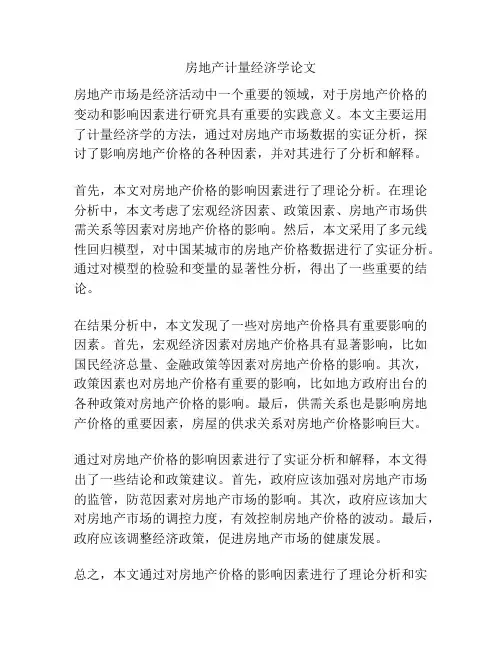
房地产计量经济学论文房地产市场是经济活动中一个重要的领域,对于房地产价格的变动和影响因素进行研究具有重要的实践意义。
本文主要运用了计量经济学的方法,通过对房地产市场数据的实证分析,探讨了影响房地产价格的各种因素,并对其进行了分析和解释。
首先,本文对房地产价格的影响因素进行了理论分析。
在理论分析中,本文考虑了宏观经济因素、政策因素、房地产市场供需关系等因素对房地产价格的影响。
然后,本文采用了多元线性回归模型,对中国某城市的房地产价格数据进行了实证分析。
通过对模型的检验和变量的显著性分析,得出了一些重要的结论。
在结果分析中,本文发现了一些对房地产价格具有重要影响的因素。
首先,宏观经济因素对房地产价格具有显著影响,比如国民经济总量、金融政策等因素对房地产价格的影响。
其次,政策因素也对房地产价格有重要的影响,比如地方政府出台的各种政策对房地产价格的影响。
最后,供需关系也是影响房地产价格的重要因素,房屋的供求关系对房地产价格影响巨大。
通过对房地产价格的影响因素进行了实证分析和解释,本文得出了一些结论和政策建议。
首先,政府应该加强对房地产市场的监管,防范因素对房地产市场的影响。
其次,政府应该加大对房地产市场的调控力度,有效控制房地产价格的波动。
最后,政府应该调整经济政策,促进房地产市场的健康发展。
总之,本文通过对房地产价格的影响因素进行了理论分析和实证分析,得出了一些重要的结论和政策建议。
这对于理解房地产价格的变动和影响因素,促进房地产市场的健康发展具有一定的理论和实践意义。
房地产市场对经济的稳定与发展具有重要作用。
本文的研究成果可以为制定未来的政策和规划提供参考,有助于有效调控房地产市场,确保房地产市场稳定和健康发展。
另外,本文的研究也有一些不足之处。
首先,由于数据的局限性,本文只对中国某城市的房地产市场进行了分析,结果可能不具有普遍适用性。
未来研究可以扩大样本范围,对更多地区的房地产市场进行研究,使研究结果更具有普适性。
房地产经济论文
房地产经济论文房地产经济论文2篇房地产经济论文范文一:低碳经济对我国房地产经济的影响我国是世界上最大的碳排放国之一,越来越严重能源危机使我国开始加快对于低碳经济的发展。
而房地产行业一直是高污染行业,所有,为了适应现在社会的发展需求,促进低碳经济的发现愈发的重要。
为了促进经济发展,消除资产泡沫,增加就业几率,低碳房地产经济的发展,对于促进绿色生产具有十分重要的意义。
低碳经济在房地产方面的展开,离不开国家支持和房地产行业内部对其的关注,当然社会整体对于低碳消费观念的认可,也是实现低碳经济的必要因素。
一、我国房地产行业走低碳发展道路的重要性对于房地产行业来说,提高能源效率以及减少废气污染的排放是低碳发展道路的主要目标,所以,我们首先要确保,使用的原料必须是无污染,无毒。
而在生产建材企业也需要符合建筑行业的地毯发展需求,才能让他们的产品对社会接纳。
所以说,房地产行业的低碳发展,最为关键的是可以推动该行业的绿色生产,绿色消费,促进下游实施。
而低碳房地产行业的发展,以降低资源的减少浪费,以得到更高质量的生活,节能减排,也是抑制气候变暖的最要措施。
二、低碳经济对我国房地产经济产生的影响1.低碳经济对房地产经济的不利影响。
1.1致使房地产的开发成本增加。
低碳经济的核心内容需要利用新能源、新材料和新技术,在我国房地产行业发展低碳经济,需要花更多的钱去开发新技术、新设施,同时更昂贵、更高效地利用能源来代替传统的高污染、高能耗的能源,实际上是一种更为昂贵的行为。
因此,低碳经济将增加房地产行业发展的成本。
1.2低碳经济会在短期内制约我国房地产经济的发展。
目前,我国的房地产建设模式所采用的共同特点是高耗能,短期内很难改变这一特点。
例如,在能源和技术上,很难在短时间内实现适当的变化。
房地产行业的发展并没有脱离能源的支持,而能源价格低廉,使用方便,使我国房地产行业得到了快速发展。
在发展低碳经济的情况下,如果失去了低能量支撑,房地产行业的发展在短期内会受到一定程度的影响和制约。
房地产经济论文15篇(分析我国房地产经济泡沫预防策略)
房地产经济论文15篇分析我国房地产经济泡沫预防策略房地产经济论文摘要:我国房地产经济在运行和发展的过程中依然存在很多的矛盾和问题,譬如说政策管理的问题,包括没有形成有效的管理体制,而相关的房地产政策缺乏一定的目的性等。
鉴于房地产行业在整个经济运行过程中的重要作用,我们有必要通过一系列的措施来规范房地产经济的发展,建立和健全发展管理机制,强化对市场的监管作用,有效的发挥市场的功效,加强规划,从而持续推动房地产行业的发展。
关键词房地产经济房地产论文房地产房地产经济论文:分析我国房地产经济泡沫预防策略论文关键词:房地产;楼市;泡沫经济论文摘要:文章对房地产市场泡沫的产生与危害及其对策作简要分析。
2010年我国政府对房地产市场进行了一系列的经济改革和政策调整,旨在抑制过快增长的房地产泡沫经济,保障房地产市场稳定健康的发展,维护广大人民的住房权利。
一、房地产市场泡沫所谓泡沫经济,是指由于人们非理性的经济活动,导致某种交易物的价格剧烈增长,这个价格远远超过其本身的价值。
这种突然形成的高价,不能长期维持,按照经济规律,经过一定的时间它必然会下降到符合其价值的水平上,这种现象就像泡沫的破裂一样,所以称作泡沫经济。
当这种现象发生在房地产市场时,便形成了房地产市场泡沫经济。
房地产市场泡沫的大规模爆发最早产生于日本。
从1985年开始,日本政府为了刺激经济发展采取了非常宽松的金融政策,鼓励资金流入房地产市场,同时由于美元贬值,大量国际资本进入日本的房地产业,导致房价飞涨,使得国民纷纷投机房地产市场。
二、我国房地产泡沫的产生近年来,由于房地产业所带来的巨大经济效益,各地政府对待房地产项目几乎是一路绿灯,在政策与经济上都给予其相当大的扶持力度,这使得房地产业的发展势头过于强劲,一跃成为国民经济的支柱产业。
但这种非理性的发展,使得房地产业已经显露出超出国民经济承受范围的苗头,房价一路飙升,许多地区的房价已经远远超过了普通民众的购买能力,“地王”与“天价”楼盘不断地涌现,房地产业已经成为暴利行业的代名词,其产生的经济泡沫也在不断增长。
房地产市场论文(5篇)
房地产市场论文(5篇)房地产市场论文(5篇)房地产市场论文范文第1篇1.全县房地产开发正处于高速进展阶段。
纵观乡宁县房地产市场近10年来的进展历程,无论是新开工面积,还是房地产投资额都消失了较快增长。
从当前市场交易状况看,全县商品房供不应求,房地产开发仍有较大进展空间。
主要缘由有:一是全县商业性房地产市场发育相对滞后,随着全县经济的进展和人民生活水平的逐步提升,合理的居民住房需求在短期内集中释放,特殊是在“羊群效应”的作用下,很多潜在购买者成为实际购买者。
再加上保障性住房、廉租房等多种住房供应形式进展缓慢,使得全社会住房需求都积聚到商品房需求上。
二是居民住房投资理念的转变及其高额回报预期,进一步增加了购房意愿。
随着县域居民金融学问普及程度不断提高,住房投资理念渐渐形成,特殊是在一般居民投资渠道不畅状况下,购买住房成为一种最简洁直接的投资方式。
特殊是最近几年房地产市场持续飙升的价格走势,增加了居民对住房投资及投机行为,使得购房意愿进一步放大。
据对乡宁县100户居民购房意愿问卷调查,有购房意愿的居民占到调查总数的81%,较上年同期增加了14个百分点,其中购房用于改善居住条件的占46%,购房用于投资增值的占35%。
特殊是居民购房增值的意愿增加,占比较去年同期增加了10个百分点。
另据调查,随着房价一路上涨和城市人口增加,商品房屋的转让和出租收入已成为县域居民财产性收入的重要来源。
乡宁县城镇居民人均财产性收入在2021~2021年5年期间增长了46.8%,出租房屋收入5年内翻了一番多。
通过对2021年住户抽样调查:乡宁县城市居民拥有两套及其以上住宅的家庭比例高达34.5%。
县级城市的经济区位、人口、规模等缘由打算了外来投资和投机性购房对县域房地产业的冲击并不大。
针对楼盘销售的专项调查显示,乡宁县城的确存在有外来投机性购房,但总量小于全部住宅成交套数的1%。
县城商品房市场的富强在很大程度上还是取决于本地需求。
房地产开发与经营论文
房地产业是我国的重要支柱产业,对国民经济有着巨大的贡献。
近年来,我国东部沿海部分地区房地产市场不断升温,房价不断上涨,引起人们的广泛关注,市场上关于房地产出现严重泡沫的声音不断增强。
在当前这种情况下,政府必须采取必要的措施来防止房地产业出现泡沫经济,那么如何正确认识房地产泡沫及如何防范房地产金融风险成了当务之急。
一、房地产泡沫与金融危机的密切相关房地产泡沫最直接的危害是加大了金融风险,当金融风险累积到一定程度,就可能产生金融危机。
根据金德尔伯格对17世纪早期至20世纪晚期各国发生的金融危机的研究,房地产在危机之前的投机热潮中屡屡扮演重要的角色,而从20世纪70年代以来,几乎在每次重要的经济危机或金融危机的酝酿和爆发过程中都伴随着房地产价格的剧烈波动。
房地产泡沫引发金融危机主要是由于借贷市场的失衡引起的。
房地产作为一个资本密集型行业,从开发到交付都需要大量的资本作为基础,而目前我国的房地产开发商规模较小,资金实力不雄厚,自有资金较少,无力进行大规模的房产开发,在这种情况下开发商必定要进行融资,在资本市场特别是证券市场融资要有一段较长时间,而且在证券市场低迷时资金有时难以筹措,而在民间进行募集成本相当高,相对于资本市场和民间筹资,银行贷款具有明显的优势。
所以在当前房地产开发中银行扮演了很重要的角色,大量的资金都投入到了房地产开发中。
由于房产业与金融业共生共荣的密切联系,一旦房地产泡沫破灭,则首先殃及的就是金融业。
房地产泡沫破灭后,房地产价格急剧下降,很多情况下跌破抵押价值,房地产企业的大量投资无法收回,经营极其困难,而且大批破产。
金融机构的呆账、坏账将大量增加。
数量庞大的不良资产因其资金滞留而危机到金融业的资产流动性及安全性,极大的破坏了银行信用制度。
泡沫经济破裂,金融系统中存在的“债务链”逐级放大,利润下降等一系列问题严重削弱了作为金融机构债权人的社会存款人对金融机构的信心,导致了大量资金的撤离,并进一步引起金融业的“多米诺骨牌效应”而使金融机构由点到面,逐个破产。
- 1、下载文档前请自行甄别文档内容的完整性,平台不提供额外的编辑、内容补充、找答案等附加服务。
- 2、"仅部分预览"的文档,不可在线预览部分如存在完整性等问题,可反馈申请退款(可完整预览的文档不适用该条件!)。
- 3、如文档侵犯您的权益,请联系客服反馈,我们会尽快为您处理(人工客服工作时间:9:00-18:30)。
关于房地产金融的论文
一、商业银行房地产金融风险的理论研究
(一)房地产金融风险的概念
国内外许多学者都做过如何界定房地产金融的内涵及外延方面的探讨和研究。
目前广为认可的说法是,广义的房地产金融是指所有与住房的开发、建设、交易、消费和经营等经济活动有关的资金融通活动。
狭义的房地产金融是指与居民或消费性的非营利住房机构的住房开发、建设、交易、消费和经营等经济活动有关的资金融通活动。
房地产金融风险是指在房地产资金融通过程中,由于无法确定的各种现实因素,使以银行为代表金融机构的实际收益与预期收益发生了一定偏差,从而具有受到损失的可能性。
(二)国内外研究综述
国外理论实证方面,AllenandGale(1998)提出基于信贷扩张的资产价格模型。
在该理论中,银行贷款是形成资产泡沫的重要原因。
Collvnsandsenhadji(2002)提出了一个使房地产业和经济周期联系起来的传播机制,并强调在监管薄弱和外资流入的情况下,该机制的作用可能放大。
Hofmann(2003)对20个主要工业化国家的房地产价格与GDP、利率和贷款量的关系进行了研究,指出房地产价格周期的变化在长期中会导致银行信贷周期的变化。
DavisandHaibinZhu(2004)选用17个国家的样本数据,对商用房地产价格和银行贷款之间的关系进行了实证分析,得出房地产价格的上涨会导致银行信贷扩张的结论。
国内理论实证方面,袁志刚、樊潇彦(2003)分析了房地产均衡价格中理性泡沫产生和存在的条件以及泡沫破灭的临界条件,认为高按揭贷款的比例是产生泡沫的原因之一。
武康平、皮舜等(2004)构建了房地产市场与银行信贷市场的一般均衡模型,通过对均衡解进行比较静态分析,得出房地产价格与银行信贷二者之间存在正反馈的作用机制。
易宪容(2005)认为中国目前出现了房地产资产泡沫,并且指出我国的房地产
市场是完全建立在银行信贷支持基础上的房地产市场。
石长
丽(2006)对房地产贷款和房地产资产泡沫进行了实证分析,结果表明商业银行房地产贷款与房地产泡沫两者存在很强的正
相关关系,商业银行房地产信贷规模对房地产价格产生直接影响。
二、商业银行房地产金融风险状况分析
(一)商品房价格大幅攀升
我国商品房销售面积不断增加,到2012年我国商品房销
售面积达到111303.65万平方米,其原因主要是由于宏观经济逐渐复苏。
房地产年销售总额也随之大幅上涨,比2003年房
地产销售总额7955.66亿元,增长了8倍多,上升到64455.79
亿元。
其中,住宅销售总额在房地产销售总额中所占比重持续占高位,自2003年至今,都在80%以上,反映出居民对住宅需求持续旺盛的态势。
(二)融资渠道单一,风险相对集中
在经历了20多年的发展以后,目前中国房地产业的资金
来源也有多种渠道,但还是以银行贷款作为主要形式,其他的
融资形式提供的资金比例很少,只能满足于少部分大企业的需求。
房地产业是典型的资本密集型产业,而在中国,由于中国
的国情大部分的房地产企业规模小,资源比较分散,不能形成
规模效益。
据资料统计,目前中国拥有80000家房地产企业,而其平均自有资本仅17949力元,企业的自有资金远远不足以完成一般的项日开发。
在中国目前的房地产市场中,各个环节中都离不开商业银行的支持和参与,商业银行在承担了房地产业几乎全部环节的风险后,又缺乏有效的风险转移手段和分散机制,造成商业银行集经营风险、市场风险和流动性风险于一身。
(三)金融市场竞争无序,信用风险增加
就商业银行本身而言,部分商业银行和其他金融机构的经营行为也存在不理性和不规范问题。
商业银行的资产业务中,由于房地产信贷的规模较大,收益率较高,加之其抵押品相对
优质,大多数商业银行都会努力开发与房地产相关的信贷业务,在经营业务时优先做有关房地产贷款甚至出现放松信贷条件
的倾向。
为了应对相对激烈的金融竞争环境,在发放房地产贷款过程中,有的商业银行为了业务量故意降低资信门坎,简化
手续等。
再如,对于有政府担保一些项目部分商业银行在处理的过程中盲目乐观,忽视了这些项目所具有的风险性。
此外,
为了争夺在市场中的份额,银行在个贷业务方面纷纷推出刺激消费的新品种,这些住房抵押产品实际上也隐藏了一定风险。
三、商业银行房地产金融风险的实证研究
1、指标选取与基础数据。
本文选取商业银行房地产贷款不良贷款率(NPL)作为商业银行房地产金融风险的衡量指标。
不良贷款率指金融机构不良贷款占总贷款余额的比重。
不良
贷款是指在贷款风险五级分类中次级、可疑和损失三类之
和。
金融机构信贷资产安全状况的重要指标之一就是不良贷
款率的高低,不良贷款率低,说明金融机构收回贷款的风险小,反之则风险大。
其计算公式为:房地产不良贷款率=(房地产次级、可疑类、损失类贷款总和)/贷款总量。
宏观经济周期,房地产市场价格变化,房地产信贷政策变化等因素均会对房地产金融风险产生影响。
本文将选取国内生产总值(GDP),货币供
应量(M2),房地产价格指数(P)三个相关指标作为自变量。
考
虑到数据的可获得性,本文选择全国2003年到2012年共10
年各项指标的数据。
2、数据处理。
为了使数据具有持续可比性,对基础数据进行了处理,商品房销售价格(P)、国内生产总值(GDP)和货币供应量(M2)均以2003年的数据为基数,记作100,处理后的数据整理如表1:实证检验结果用Eviews8.0软
件对因变量指标与3个自变量指标进行多元回归分析,以求出因变量与自变量的回归方程,掌握变量之间的函数关系,结果
如表2:由上表可以看出,不良贷款率与GDP指数、货币供应量指数、房地产价格指数3个指标相关性较高,其判别P值分别为0.0202、0.0034、0.0093,均小于显著性指标0.050,所以
可以认为因变量与自变量之间存在线性关系。
判定系数R2为
0.95,说明模型拟合效果较好。
采用最小二乘法来计量不良贷款率与GDP,房地产价格,货币供应量三者之间的关系,得出如下线性回归方程:由上述回归方程可以看出,货币供应量指数(M2)、GDP指数、房地产价格指数(P)对对房地产不良贷款率的影响较均为显著。
房地产不良贷款率和GDP指数、房地产价格指数的关系是负相关性的,房地产不良贷款率和货币工供应量指数具有正相关性。
房地产金融风险的高低与宏观经济周期呈反向关系。
房地产金融风险的高低与房地产价格指数呈反向变化。
四、防范房地产金融业务风险的对策
(一)稳妥推行住房抵押贷款证券化
抵押贷款证券化可以有效地分散和转移风险,提高资产的流动性,解决银行抵押贷款“短期负债支持长期资产”的流动性难题,与此同时抵押贷款证券化也对刺激抵押贷款一级市场有积极的促进作用。
首先,要培育抵押贷款证券化市场。
发行抵押贷款证券必须建立完善的、流动性较强的抵押贷款二级市场。
因此,要制定相关的法律法规,深化金融体制改革。
其次,建立完善的抵押市场担保体系。
开展住房抵押贷款证券化必须先解决好抵押证券的安全性和清偿能力两个方面的问题,因此必须稳妥推行住房抵押贷款证券化,设立专门的证券化担保机构。
最后,探索新的住房抵押贷款的证券化途径。
途径的创新关系到住房抵押贷款证券化的可持续发展,是防范流动性风险的长久之计。
(二)发展房地产信托,完善房地产金融工具体系
信托具有独特的制度设计功能,能够起到避税、财产隔离的功能,而且其所具有的创新性、灵活性、收益性三大特点,使信托的应用范围广泛,可用于货币市场、资本市场、产业市场等多种市场,同时信托适合管理长期资金的特点,使其天然地具有了便于和房地产相结合的特性,而广泛的市场兼容性,又为房地产信托开拓了广阔的发展空间。
首先,要大力发展“股权+贷款”形式的房地产投资信托基金。
其次,要为我国
房地产投资信托基金进入实施运作创造必要的法律环境。
最后,应逐步完善证券场外交易市场和产权交易市场,使基金的资金收入与回收机制更为完善。
(三)完善房地产金融的体系建设与立法工作
纵观发达国家,为了保证本国房地产市场和房地产金融的健康发展,不仅在机构建设上趋于完备,而且都有着较为完善的房地产金融法律体系。
这些机构和法律体系的建立对房地产企业与个人所涉及的各项房地产金融业务都做出了详细的指导和规范,减少了各种违法违规现象的发生,从而降低了房地产金融风险。
我国也应学习发达国家的进成功经验,不断完善房地产金融的机构建设与立法进程。
